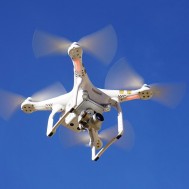Drones, or Unmanned Aerial Vehicles (UAVs) or Unmanned Aircraft Systems (UAS), are defined by Merriam-Webster as “unmanned aircraft or ship guided by remote control or onboard computers.”
Many of us first heard the term “drone” used by the media nearly 15 years ago when the U.S. military began using them in the Afghanistan War. Fast forward to 2016, and we’re using smaller-sized drones to deliver takeout orders and aid rescuers in saving lives during natural disasters.
The Federal Aviation Administration (FAA) estimates that about 2.5 million drones regularly take flight across the U.S. By 2020, that number could nearly triple to 7 million drones. As commercial use restrictions in the United States become less stringent, their potential is seemingly endless.
Here are 5 ways that drones will change the world of manufacturing:
Sourcing
As the first step in the manufacturing process, drones can be used to discover sources of raw materials necessary to manufacture finished goods. Small or medium sized drones equipped with cameras can obtain quality aerial views from much lower heights than airplanes. At these lower altitudes, other geographical or physical characteristics of a region may be obtained. This data can be analyzed and used to create roads or other access to resources. Besides these more obvious advantages, a drone is less expensive to own and operate than a plane. Dr. Robin Murphy, a robotics professor at Texas A&M University, told CNN, “It acts like a plane. It’s smarter than a plane because it’s got all sorts of onboard electronics to let it do pre-program surveys.”
Increased safety
The same technology that makes drones an excellent option for sourcing is also a benefit to human safety. Because of their maneuverability and size, small drones are able to get to places that might be difficult or even unsafe for an employee. A drone could inspect or repair the insides of vats or other large vessels where it may be difficult or less safe for an employee to climb in and do the job. Drones could be used in other hazardous situations like combining chemical compounds or to obtaining samples of extremely hot or cold in-process materials.
They could also be used for less complicated tasks such as changing light bulbs in warehouses thereby eliminating the safety risk posed by an employee on a ladder. Need a product from the top shelf in a warehouse? Instead of climbing up a ladder and risking a fall, just send the drone up! Any company with a Safety First Operational Approach will appreciate the solutions that drones will provide.
Improved transport
A drone equipped with a robotic arm or other specialized holding mechanism can transport any number of things from one place to another. They can transport products within warehouses or stores, refill caches in a production line, or make deliveries between company locations. Recently, several companies started delivering takeout via drone! The app Foodpanda has been testing food delivery in Singapore; if all goes according to plan, it will mean shorter wait times for customers and increased profit for the company.
The advantages of drone transport seem to go on forever: decreased fuel costs, faster transport times and fender benders, and real-time delivery monitoring so you know where your delivery is at all times.
Heightened Quality Assurance
Another way that a drone will change manufacturing is to assist in quality assurance (QA) assignments. According to a PV Insider article, drone inspection teams at a solar plant in South Africa have improved work time by 20 to 30 percent and have reduced the cost of inspections by 30 to 40 percent.
Drones can assist manufacturing QA teams several ways:
- Inspect processing and production equipment for functionality via live video feed
- Monitor production levels via live video feed
- Obtain product samples from the production line and deliver them to the QA official for physical inspection
- Perform a variety of aerial imaging and sensing such as infrared and thermal
- Retrieve measurements from on-board sensors to detect problems with environmental quality
Real-time inventory and asset monitoring
Inventory and asset monitoring with the help of drones has two major advantages to manufacturing: 1) real-time inventory and asset tracking and 2) maximizing automation, both of which save time and money. How does it work? The drone software is programmed to take inventory using one of the following methods:
1. RFID Chips (Radio Frequency Identification Chips) – Also referred to as microchips, RFID chips contain electronically stored data that can be scanned outside a line of sight.
2. QR Codes (Quick Response Codes) – A two-dimensional matrix barcode that consists of black square dots arranged in a square grid with a white background. A QR code must be within the line of sight to be scanned.
3. Bar code – A representation of data using varying widths and spacings of parallel lines that are also known as one-dimensional codes.
Since most companies already employ one of these three methods of monitoring, the only remaining step is to purchase a drone programmed to the codes that are already in use. According to Exponent, a company that offers drone solutions for asset tracking and inventory management, the drones can be equipped to fly on pre-programmed flight paths or can be controlled by ground personnel. Either way, a drone can make quick work of flying through a warehouse and taking inventory.
Our MicrOring seals play pivotal roles in the manufacturing of drones. Our small size O-Rings can be used for sealing sensors, motors and controls, which help limit size and reduce weight without sacrificing sealability.
Drones aren’t only changing the world of manufacturing — they are rapidly changing the way that companies do business. Want to talk more about drones and how they can help you? Connect with us on Twitter or contact our engineering team.

